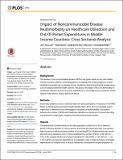Impact of Noncommunicable Disease Multimorbidity on Healthcare Utilisation and Out-Of-Pocket Expenditures in Middle-Income Countries: Cross Sectional Analysis

View/
Author
Lee, John Tayu
Hamid, Fozia
Pati, Sanghamitra
Millett, Christopher
Published Version
https://doi.org/10.1371/journal.pone.0127199Metadata
Show full item recordCitation
Lee, John Tayu, Fozia Hamid, Sanghamitra Pati, Rifat Atun, and Christopher Millett. 2015. “Impact of Noncommunicable Disease Multimorbidity on Healthcare Utilisation and Out-Of-Pocket Expenditures in Middle-Income Countries: Cross Sectional Analysis.” PLoS ONE 10 (7): e0127199. doi:10.1371/journal.pone.0127199. http://dx.doi.org/10.1371/journal.pone.0127199.Abstract
Background: The burden of non-communicable disease (NCDs) has grown rapidly in low- and middle-income countries (LMICs), where populations are ageing, with rising prevalence of multimorbidity (more than two co-existing chronic conditions) that will significantly increase pressure on already stretched health systems. We assess the impact of NCD multimorbidity on healthcare utilisation and out-of-pocket expenditures in six middle-income countries: China, Ghana, India, Mexico, Russia and South Africa. Methods: Secondary analyses of cross-sectional data from adult participants (>18 years) in the WHO Study on Global Ageing and Adult Health (SAGE) 2007–2010. We used multiple logistic regression to determine socio-demographic correlates of multimorbidity. Association between the number of NCDs and healthcare utilisation as well as out-of-pocket spending was assessed using logistic, negative binominal and log-linear models. Results: The prevalence of multimorbidity in the adult population varied from 3∙9% in Ghana to 33∙6% in Russia. Number of visits to doctors in primary and secondary care rose substantially for persons with increasing numbers of co-existing NCDs. Multimorbidity was associated with more outpatient visits in China (coefficient for number of NCD = 0∙56, 95% CI = 0∙46, 0∙66), a higher likelihood of being hospitalised in India (AOR = 1∙59, 95% CI = 1∙45, 1∙75), higher out-of-pocket expenditures for outpatient visits in India and China, and higher expenditures for hospital visits in Russia. Medicines constituted the largest proportion of out-of-pocket expenditures in persons with multimorbidity (88∙3% for outpatient, 55∙9% for inpatient visit in China) in most countries. Conclusion: Multimorbidity is associated with higher levels of healthcare utilisation and greater financial burden for individuals in middle-income countries. Our study supports the WHO call for universal health insurance and health service coverage in LMICs, particularly for vulnerable groups such as the elderly with multimorbidity.Other Sources
http://www.ncbi.nlm.nih.gov/pmc/articles/PMC4496037/pdf/Terms of Use
This article is made available under the terms and conditions applicable to Other Posted Material, as set forth at http://nrs.harvard.edu/urn-3:HUL.InstRepos:dash.current.terms-of-use#LAACitable link to this page
http://nrs.harvard.edu/urn-3:HUL.InstRepos:17820728
Collections
- SPH Scholarly Articles [6362]
Contact administrator regarding this item (to report mistakes or request changes)


